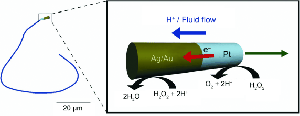Adding a silver-gold alloy to nanorods fuelled by hydrogen peroxide gives them a significant speed boost, according to US chemists.
The idea of nanobots that can be jettisoned into the blood stream and will race around the body scraping off cholesterol plaques from the inside of arteries, zapping tumours, and spiking invading microbes, remains firmly in the realm of science fiction…at least for now. However, scientists are taking the first tentative steps towards building the sub-microscopic components that these nanobots will need to work.

Professor Joseph Wang
One essential component is a propulsion system for the nanomachines. Now, Joseph Wang, and his team at the University of California, San Diego, USA, and colleagues at Arizona State University, in Tempe, have developed a tiny motor based on nanorods, which they say can swim extremely fast. The new devices are almost as fast moving as the best biological nanomachines, bacteria.
These nanorods travel about 75 times their own length in one second, explains Wang, We are approaching the speed of the most efficient biological nanomotors, including flagellated bacteria.

Nanorods of precious metal alloys propel themselves forward with catalytic power (Credit: Wang et al/Wiley-VCH)
Rather than acting as the driving force for a nanobot, the first simple application of a nanomotor might be to quickly transport a payload pharmaceutical or other therapeutic agent to a specific target site in the body. Similar devices might also be used to drive diagnostic or environmental sample molecules through the microscopic channels of lab-on-a-chip (LoC) or microelectromechanical systems (MEMS) devices.
The team points out that, generating forward propulsion on this scale and fighting, molecular diffusion effects and viscosity is not as trivial as it seems. With this in mind, the team created their nanomotors from catalytic rods with a different metal at each end. The researches used platinum at one end of the nanorods and a silver-gold alloy at the other. With hydrogen peroxide added as a fuel to the system they were able to propel the nanorods to speeds of 150 micrometres per second (0.54 metres per hour).
The platinum catalyses the splitting of hydrogen peroxide into oxygen gas and hydrogen ions, and absorbs the electrons released in the process. These are absorbed by the silver-gold segment, which then accelerates a kind of reverse reaction in which hydrogen peroxide and protons combine to form water. The concomitant production of oxygen and water generates an electrical current that drives the nanorod through the fluid, platinum head first.
The silver-gold alloy causes the electrons to be transferred more quickly [than with gold alone], explains Wang, This increases the fuel decomposition rate and the nanorod is accelerated faster. The team explains that by fine-tuning the amount of silver in the alloy they can control the speed of the nanorods. Fuel additives or variations of the platinum segment will make these rods even faster, predicts Wang. The team also intends to find a way to generate hydrogen peroxide in situ from glucose to fuel the nanorods for applications in the human body.
U. Korcan Demirok, Rawiwan Laocharoensuk, Kalayil Manian Manesh, Joseph Wang (2008). Ultrafast Catalytic Alloy Nanomotors Angewandte Chemie International Edition DOI: 10.1002/anie.200803841
Further reading
J. Am. Chem. Soc., 2008, 130, 8164-8165
http://dx.doi.org/10.1021/ja803529u
Professor Joseph Wang homepage
http://nanoengineering.ucsd.edu/~joewang/